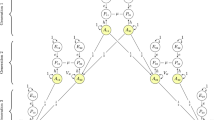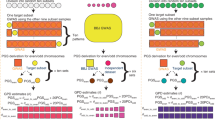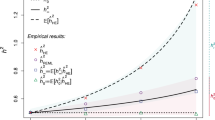Abstract
OBJECTIVE: Prevalence rates of obesity have been increasing in several countries over the past two decades. Mainly secular changes in energy intake and expenditure have been invoked to underly the increasing rates; genetic factors have not been considered because of the very recency of this phenomenon. We hypothesize that genetic factors might very well be involved via an increased rate of assortative mating between obese individuals. We speculate that the recent upsurge in social stigmatization of obese individuals underlies the hypothesized increase in assortative mating.
DESIGN: To accumulate evidence for our hypothesis we analysed deduced rates of assortative mating among parents of extremely obese children and adolescents, who belonged to two different large study groups (n=201 and n=270). For this purpose we calculated parental body mass indices (BMIs) based on (a) measured current heights and weights, (b) self-reported current heights and weights, and finally (c) measured current heights and recalled weights at ages 20 and 30, respectively. BMI centiles were determined which in turn were attributed to the respective BMI decile. Deduced rates of assortative mating were evaluated in bivariate histograms of the paternal and maternal BMI deciles.
RESULTS: High rates of assortative mating were observed as deduced from the bivariate histograms, which revealed a fairly consistent pattern. Thus, in the first study group almost 35% of the parental pairs had a BMI in the tenth decile; over 50% of the mothers and fathers had a BMI in this top decile. Recalled parental BMIs at ages 20 and 30 also clustered in the upper decile. These results were basically replicated in the second study group. In addition, parental loading on the tenth decile was shown to be higher for the subgroup of children and adolescents who had a BMI equal to or exceeding the highest BMI of the population-based age and gender matched control group.
CONCLUSIONS: Our results indicate that assortative mating is common among parents of extremely obese children and adolescents, ascertained between 1995 and 1997. In addition, the parental loading on the tenth decile is most prominent for the most obese children. Whereas we are unable to document an increased rate of assortative mating, we interpret our results as being consistent with the hypothesis that an increased rate of assortative mating has contributed to the recent rise in obesity rates in several countries. Thus, assortative mating warrants further studies to assess its impact on obesity prevalence rates through both genetic and non-genetic mechanisms. Our results suggest that assortative mating might especially increase the rates for extreme obesity.
This is a preview of subscription content, access via your institution
Access options
Subscribe to this journal
Receive 12 print issues and online access
$259.00 per year
only $21.58 per issue
Buy this article
- Purchase on Springer Link
- Instant access to full article PDF
Prices may be subject to local taxes which are calculated during checkout





Similar content being viewed by others
References
Taubes G . Demographics—as obesity rates rise, experts struggle to explain why Science 1998 280: 1367–1368.
Troiano RP, Flegal KM, Kuczmarski RJ, Campbell SM, Johnson CL . Overweight prevalence and trends for children and adolescents: the National Health and Nutrition Examination Surveys, 1963 to 1991 Arch Pediatr Med 1995 149: 1085–1091.
Barth N, Ziegler A, Himmelmann GW, Coners H, Wabitsch M, Hennighausen K, Mayer H, Remschmidt H, Schäfer H, Hebebrand J . Significant weight gains in a clinical sample of obese children and adolescents between 1985 and 1995 Int J Obes 1997 21: 122–126.
Prentice AM, Jebb SA . Obesity in Britain: Gluttony or sloth? Br Med J 1995 311: 437–439.
Hinney A, Barth N, Ziegler A, von Prittwitz S, Hamann A, Hennighausen K, Lentes K-U, Heils A, Rosenkranz K, Roth H, Coners H, Mayer H, Herzog W, Siegfried A, Lehmkuhl G, Poustka F, Schmidt MH, Schäfer H, Grzeschik K-H, Pirke KM, Lesch KP, Remschmidt H, Hebebrand J . Serotonin transporter gene-linked polymorphic region: allele distributions in relationship to body weight and in anorexia nervosa Life Sci 1997 61:PL: 295–303.
Hinney A, Becker I, Heibult O, Nottebom K, Schmidt A, Ziegler A, Mayer H, Siegfried W, Blum WF, Remschmidt H, Hebebrand J . Systematic mutation screening of the pro-opiomelanocortin gene: Identification of several genetic variants including three different insertions, one nonsense and two missense point mutations in probands of different weight extremes J Clin Endocrinol Metab 1998 83: 3737–3741.
Hinney A, Schmidt K, Nottebom O, Heibült I, Becker A, Ziegler G, Gerber M, Sina T, Görg H, Mayer W, Siegfried M, Fichter H, Remschmidt J, Hebebrand . Several mutations in the melanocortin-4 receptor gene including a nonsense and a frameshift mutation associated with dominantly inherited obesity in humans J Clin Encocrinol Metab 1999 84: 1483–1486.
Rosenkranz K, Hinney A, Ziegler A, von Prittwitz S, Barth N, Roth H, Mayer H, Siegfried W, Lehmkuhl G, Poustka F, Schmidt M, Schäfer H, Remschmidt H . Screening for mutations in the neuropeptide Y Y5 receptor gene in cohorts belonging to different weight extremes Int J Obes 1998 22: 157–163.
Roth H, Korn T, Rosenkranz K, Hinney A, Ziegler A, Kunz J, Siegfried W, Mayer H, Hebebrand J, Grzeschik K-H . Transmission disequilibrium and sequence variants at the leptin receptor gene in extremely obese German children and adolescents Hum Genet 1998 103: 540–546.
Hebebrand J, Heseker H, Himmelmann GW, Schäfer H, Remschmidt H . Altersperzentilen für den Body Mass Index aus Daten der Nationalen Verzehrsstudie einschließlich einer Übersicht zu relevanten Einflußfaktoren Aktuelle Ernährungsmedizin 1994 19: 259–265.
Hebebrand J, Himmelmann GW, Heseker H, Schäfer H, Remschmidt H . Use of percentiles for the body mass index in anorexia nervosa: Diagnostic, epidemiological, and therapeutic considerations Int J Eat Disord 1996 19: 359–369.
Hebebrand J, Himmelmann GW, Herzog W, Herpertz-Dahlmann BM, Steinhausen HC, Amstein M, Seidel R, Deter HC, Remschmidt H, Schäfer H . Prediction of low body weight at long-term follow-up in acute anorexia nervosa by low body weight at referral Am J Psychiat 1997 154: 566–569.
Hebebrand J, Henninghausen K, Nau S, Himmelmann GW, Schulz E, Schäfer H, Remschmidt H . Low body weight in male children and adolescents with schizoid personality disorders or Asperger's disorders Acta Psychat Scand 1997 96: 64–67.
Hennighausen K, Rischmüller B, Heseker H, Remschmidt H, Hebebrand J . Low body mass indices in adolescents with obsessive compulsive disorder Acta Psychiatr Scand 1999 99: 267–273.
Garn SM, Sullivan TV, Hawthorne VM . Educational level, fatness, and fatness differences between husbands and wives Am J Clin Nutr 1989 50: 740–745.
Allison DB, Nealoe MC, Kezis MI, Alfonso VC, Heshka S, Heymsfield SB . Assortative mating for relative weight: genetic implications Behav Genet 1996 26: 103–111.
Maes HH, Neale MC, Eaves LJ . Genetic and environmental factors in relative body weight and human adiposity Behav. Genet. 1997 27: 325–351.
Dunlop DM, Lyon RM . Study of 523 cases of obesity Edinburgh Med J 1931 38: 561–577.
Fellows HH . Studies of relatively normal obese individuals during and after dietary restrictions Am J Med Sci 1931 181: 301–312.
Ellis RWB, Tallerman KH . Obesity in childhood Lancet 1934 615–620.
Gurney R . he hereditary factor in obesity Arch Intern Med 1936 57: 557–561.
Bauer J . Constitution and disease. Applied constitutional pathology, 2nd edn Grune & Stratton: New York, 1947.
Angel JL . Constitution in female obesity Am J Phys Anthropolo 1949 7: 433–471.
Iversen T . Psychogenic obesity in Children. I Acta Psychiat Scand 1953 42: 8–19.
Mayer J . Genetic factors in obesity Bull NY Acad Med 1960 36: 322–343.
Withers RFJ . Problems in the genetics of human obesity Eugen Rev 1964 56: 81–90.
Adams TD, Hunt St, Mason LA, Ramirez ME, Fisher AG, Williams RR . Familial aggregation of morbid obesity Obes Res 1993 1: 261–270.
Laskarzewski PM, Khoury P, Morrison JA, Kelly K, Mellies MJ, Glueck CJ . Familial obesity and leanness Int J Obes 1983 7: 505–527.
Hunt SC, Williams RR, Adams TD . Biochemical and anthropometric characterization of morbid obesity in a large Utah pedigree Obes Res 1995 3: 165s–172s.
Westenhöfer J, Pudel V . Einstellungen der deutschen Bevölkerung zum Essen Ernährungsumschau 1990 37: 311–316.
Brown PJ, Bentley-Condit VK . Culture, evolution, and obesity. In Bray GA, Bouchard C, James WPT (eds). Handbook of obesity Marcel Dekker; New York 1998.
Casey VA, Dwyer JT, Coleman KA, Valadian I . Body mass index from childhood to middle age: a 50-y follow-up Am J Clin Nutr 1992 56: 8–14.
Casey VA, Dwyer JT, Berkey CS, Coleman KA, Gardner J, Valadian I . Long-term memory of body weight and past weight satisfaction: a longitudinal follow-up study Am J Clin Nutr 1991 53: 1493–1498. .
Bouchard C, Pérusse L . The genetics of human obesity. In Bray GA, Bouchard C, James WPT (eds). Handbook of obesity Marcel Dekker: New York 1998.
Ziegler A, Hebebrand J . Sample size calculations for linkage analysis using extreme sib pairs based on segregation analysis with the quantitative phenotype body weight as an example Genet Epidemiol 1998 15: 577–593.
Vaisse C, Clement K, Guygrand B, Froguel P . A frameshift mutation in human MC4R is associated with a dominant form of obesity Nature Genet 1998 20: 113–114.
Yeo GSH, Farooqi IS, Aminian S, Halsall DJ, Stanhope RC, Orahilly S . A frameshift mutation in MC4R associated with dominantly inherited human obesity Nature Genet 1998 20: 111–112.
Author information
Authors and Affiliations
Corresponding author
Rights and permissions
About this article
Cite this article
Hebebrand, J., Wulftange, H., Goerg, T. et al. Epidemic obesity: are genetic factors involved via increased rates of assortative mating?. Int J Obes 24, 345–353 (2000). https://doi.org/10.1038/sj.ijo.0801135
Received:
Revised:
Accepted:
Published:
Issue Date:
DOI: https://doi.org/10.1038/sj.ijo.0801135
Keywords
This article is cited by
-
The associations of maternal and paternal obesity with latent patterns of offspring BMI development between 7 and 17 years of age: pooled analyses of cohorts born in 1958 and 2001 in the United Kingdom
International Journal of Obesity (2023)
-
Intergenerational transmission of body mass index and associations with educational attainment
BMC Public Health (2022)
-
The promise of new anti-obesity therapies arising from knowledge of genetic obesity traits
Nature Reviews Endocrinology (2022)
-
Recruitment strategies in a prospective longitudinal family study on parents with obesity and their toddlers
BMC Public Health (2017)
-
Obesity, More than a ‘Cosmetic’ Problem. Current Knowledge and Future Prospects of Human Obesity Genetics
Biochemical Genetics (2016)



